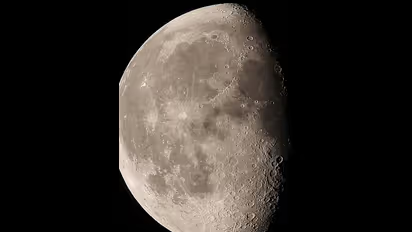Chandrayaan-3 can reach moon before Russia's Luna-25: Ex-ISRO scientist

Synopsis
Former ISRO scientist Tapan Mishra says that ISRO possesses the capability to execute a flawless landing of Chandrayaan-3 at the designated site, aligning with the latest scientific data, up to four days prior to the planned date.
The lunar endeavours of both India and Russia have stirred global anticipation as Chandrayaan-3 and Luna-25 head closer to the moon. Notably, both missions are aiming for the elusive south pole of the moon, a region untouched by sunlight for aeons and unexplored by any nation. While the two missions are projected to achieve a remarkable milestone, they are anticipated to land at a distance of approximately 120 kilometres from each other. Despite the proximity, both ventures are vying to achieve their lunar descent on the same day.
Chandrayaan-3, India's lunar mission, embarks on a trajectory of about 27 days to reach its destination, while Russia's Luna-25 boasts an astonishingly swift voyage, with an estimated moon landing in just 10 to 11 days. Luna-25's rapid journey is attributed to its launch via the potent Soyuz 2.1 rocket, which bypasses the Earth's orbit, directly guiding it to the moon's domain.
The world is now captivated by the unfolding competition between Chandrayaan-3 and Luna-25, both striving to conquer the uncharted south pole of the moon, an endeavour no country has accomplished before. The impending simultaneous landings have sparked global discussions, fueling comparisons and excitement surrounding this epoch-making feat.
Tapan Mishra, a former ISRO scientist, has emphasized the dissimilarity between the two missions and downplayed any sense of rivalry. He underscores the distinctiveness of India's Chandrayaan-3 mission, highlighting its modest cost of Rs 615 crore, which he analogizes to the expense of a small domestic flyover project.
Mishra accentuates the scientific prowess of Chandrayaan-3, citing ISRO's precise orbital calculations and trajectory adjustments. He elucidates how ISRO's advanced planning can ensure the mission's precise landing days ahead of schedule if desired.
Drawing a comparison with Russia's Luna-25, Mishra underscores the economical nature of Chandrayaan-3's mission, accomplished within a mere three years. In contrast, Russia has invested extensive resources in Luna-25 since the 1990s, incurring costs far exceeding those of Chandrayaan-3.
Furthermore, Mishra underscores the unique approach ISRO took in launching Chandrayaan-3, employing the slingshot mechanism and gravity assist technique to manoeuvre around Earth's orbit before reaching the lunar orbit. In contrast, Luna-25 employed a powerful rocket to directly transition from Earth's orbit to the moon's orbit, a method necessitating advanced technology not utilized in Chandrayaan-3.
In essence, the race for lunar exploration unfolds against a backdrop of uniqueness, with India's Chandrayaan-3 embracing innovation and cost-effectiveness, while Russia's Luna-25 leans on extensive resources and long-term planning. Both missions, however, embody the spirit of scientific advancement and exploration, ushering in an era of remarkable achievements in space exploration.
Stay updated with the Breaking News Today and Latest News from across India and around the world. Get real-time updates, in-depth analysis, and comprehensive coverage of India News, World News, Indian Defence News, Kerala News, and Karnataka News. From politics to current affairs, follow every major story as it unfolds. Get real-time updates from IMD on major cities weather forecasts, including Rain alerts, Cyclone warnings, and temperature trends. Download the Asianet News Official App from the Android Play Store and iPhone App Store for accurate and timely news updates anytime, anywhere.